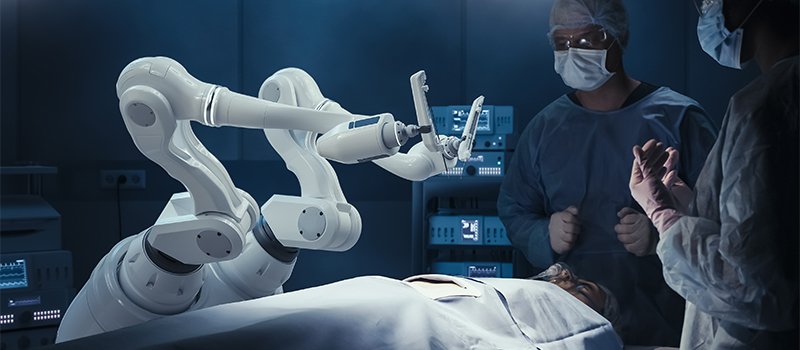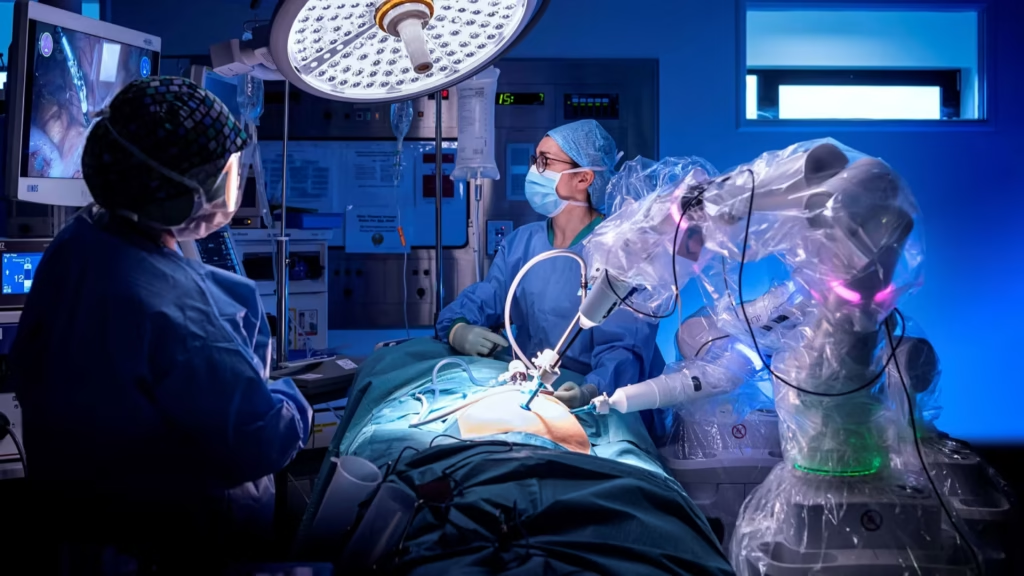In hospitals across the United Arab Emirates, a new wave of advanced technology is quietly reshaping healthcare. Robotic surgery in UAE is now helping doctors carry out complex operations with more precision and control. For patients, this means smaller cuts, less bleeding, and a quicker return to normal life.
This high-tech approach is not science fiction anymore — it’s already in use at top hospitals in Dubai, Abu Dhabi, and Sharjah. From removing cancerous tumors to repairing heart valves and carrying out gynecological procedures, robotic surgery is proving to be a safer and more efficient option for many types of treatments.
What is robotic surgery and how does it work?
Robotic surgery does not mean that robots operate on patients alone. Instead, skilled doctors guide robotic arms that help them perform delicate procedures with more accuracy.

These robotic systems are equipped with high-definition 3D cameras and fine instruments that allow surgeons to operate through tiny cuts, also called keyhole surgery. The surgeon sits at a console and uses hand and foot controls to guide the robotic arms with great precision.
According to doctors, robotic tools can bend and rotate more than a human hand, which helps in reaching hard-to-access areas inside the body.
Benefits of robotic surgery in UAE hospitals
Robotic surgery in UAE has become popular because of the benefits it offers both patients and doctors.
For patients:
- Smaller incisions mean fewer stitches and minimal scarring
- Less blood loss during surgery
- Reduced pain after the operation
- Faster recovery and shorter hospital stays
- Lower risk of infection or post-surgery complications
For doctors:
- Better visibility inside the body through 3D imaging
- More control and flexibility during the surgery
- Ability to perform difficult procedures with ease
Many leading UAE hospitals, such as Cleveland Clinic Abu Dhabi and Mediclinic City Hospital in Dubai, have already adopted robotic systems like the da Vinci Surgical System for different medical specialties.
Real patient stories show how robotic surgery is helping
Doctors in the UAE have shared inspiring patient cases that highlight the power of robotic surgery.
In one case, a woman suffering from uterine fibroids underwent robotic-assisted surgery in Dubai. She was discharged within 24 hours and resumed her routine within a week — a much shorter recovery compared to traditional surgery.
In another case, a man with early-stage kidney cancer had a tumor removed using robotic tools. The surgery left only small scars and helped him keep most of his kidney.
These stories are becoming more common as hospitals across the UAE continue to upgrade their surgical departments with the latest technology.
Which surgeries are done using robotic systems in UAE?

The range of surgeries done with robotic assistance is expanding rapidly. Currently, robotic surgery in UAE is used in the following specialties:
- Urology (prostate and kidney surgeries)
- Gynecology (hysterectomies, endometriosis treatment)
- General surgery (gallbladder removal, hernia repair)
- Cardiac surgery (valve repair and artery bypass)
- Oncology (tumor removal and biopsies)
Doctors say the minimally invasive approach provided by robotic tools is especially helpful in cancer treatments, where preserving healthy tissue is critical.
UAE is investing heavily in robotic healthcare technologies
The UAE’s healthcare sector is seeing strong investment in artificial intelligence (AI) and robotics. Hospitals are racing to keep up with global medical standards by bringing in modern robotic systems and training their surgeons.
In 2024, Dubai Healthcare City launched a dedicated training centre for robotic surgery, aimed at giving doctors hands-on experience with the machines.
The country’s leadership has also shown support for innovation in the healthcare field, with policies encouraging faster adoption of robotic systems in public and private hospitals.
How affordable is robotic surgery in UAE?
While robotic surgery is more advanced, it can also be more expensive than traditional procedures due to the cost of equipment and training. However, UAE hospitals are working to make these surgeries more accessible.
Some insurance plans now cover robotic procedures, and as more hospitals adopt the technology, the cost is expected to become more affordable in the future.
Doctors believe that the long-term benefits — such as quicker recovery and fewer follow-up visits — make robotic surgery a cost-effective choice for many patients.
Doctors say robotic surgery is the future of medicine
UAE doctors see robotic surgery as the future of medicine.
Dr. Mohamad Allaf, a urologist at a leading hospital in Abu Dhabi, said, “We’re now able to carry out complex surgeries that once required large cuts and long recoveries, in just a few hours with minimal pain.”
Other doctors agree that robotic surgery is a win-win for both the medical team and the patient. It gives more control to surgeons and allows patients to go home faster and with fewer risks.
What’s next for robotic surgery in the UAE?

The next step is expanding the availability of robotic surgery across all hospitals, including smaller regional facilities. Efforts are also underway to train more surgeons in the use of robotics, so patients across the UAE can benefit from the technology.
There are also plans to include AI and machine learning in future robotic systems. These advancements will help robots learn from past surgeries, assist surgeons in decision-making, and even detect problems early.
Conclusion: UAE leads the region in robotic medical innovation
Robotic surgery in UAE is more than just a trend — it’s a game-changing medical revolution. With better tools, improved outcomes, and faster healing times, both patients and doctors are seeing the benefits.
As hospitals continue to adopt new technologies, the UAE is setting a strong example for how advanced medicine can improve lives, save time, and offer safer options to those in need of surgery.
Whether it’s cancer treatment, heart care, or a routine procedure, robotic surgery is bringing the future of healthcare to operating rooms today.
Read More: UAE Debt Relief For Citizens Begins With $39 Million Loan Waiver











